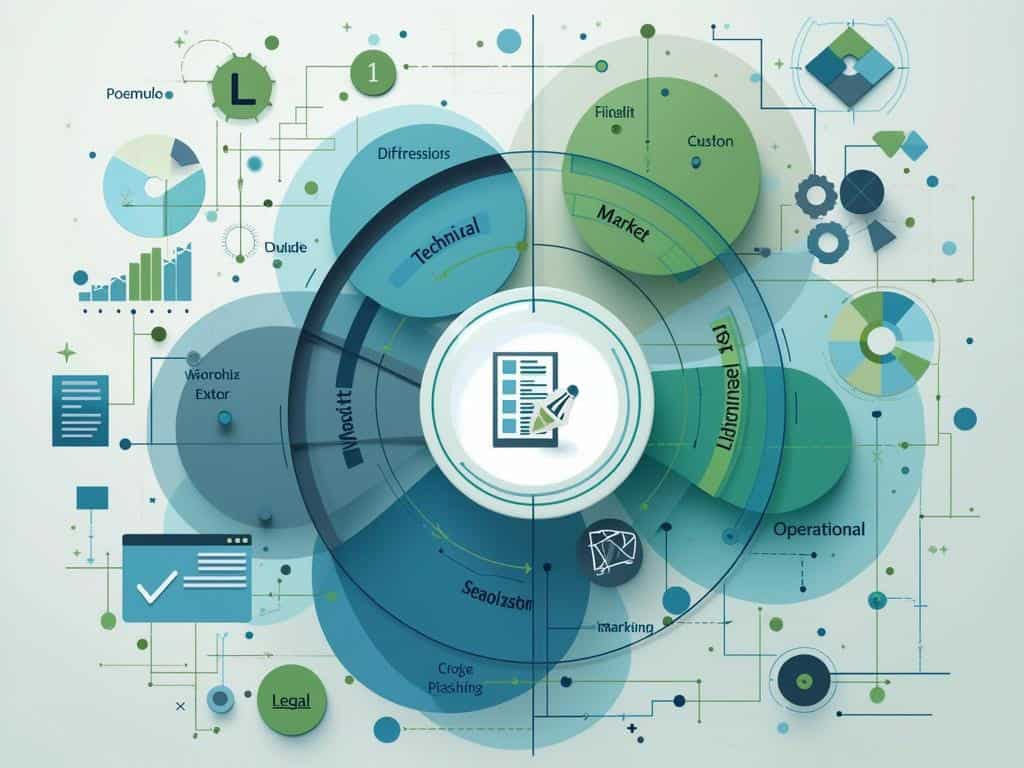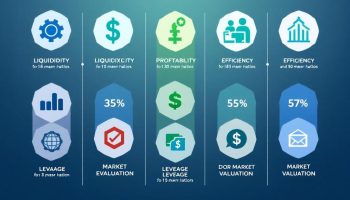
A Feasibility Study Example for IT Project Planning
A feasibility study example for IT project planning creates a systematic framework to evaluate technological initiatives before committing resources. This assessment helps organizations analyze technical, financial, market, and operational potential, serving as a critical decision-making tool that minimizes risks and improves resource allocation.
Key Takeaways:
- Feasibility studies can improve project success rates by 30-50% through comprehensive evaluation
- Comprehensive analysis covers technical, financial, market, operational, and legal dimensions
- Identifies potential roadblocks and challenges before significant resource investment
- Provides evidence-based framework for project approval and stakeholder confidence
- Establishes baseline metrics for measuring project success and alignment with organizational strategy
Conducting thorough feasibility studies has become essential in today’s competitive IT landscape. Your organization can benefit significantly from this structured approach to project planning. These studies don’t just highlight potential problems—they also reveal opportunities for innovation and competitive advantage.
The digital transformation era demands careful evaluation of all aspects before launching new IT initiatives. You’ll need to balance technical possibilities with practical constraints. Many successful enterprises now consider feasibility studies a standard requirement rather than an optional step in their project management methodology.
Each dimension of a feasibility study contributes unique insights. Technical feasibility examines infrastructure requirements, while financial assessment calculates ROI and TCO. The market analysis confirms demand, operational evaluation ensures implementation readiness, and legal review confirms compliance with regulatory standards. Together, these components create a comprehensive picture of project viability.
“Conducting a thorough feasibility study is the cornerstone of successful IT project planning, enhancing project success rates by 30-50% while strategically identifying potential roadblocks before resource commitment. This systematic assessment not only secures stakeholder confidence but also aligns initiatives with organizational goals, transforming risks into informed opportunities.”
Understanding Feasibility Studies in IT Project Management
A feasibility study example for IT project planning serves as your foundation for evaluating viability before committing significant resources. This systematic process helps you assess the technical, financial, market, and operational potential of your IT initiative, functioning as a critical decision-making tool that reduces risks and optimizes resource allocation.
Your IT project feasibility study directly impacts success rates, with projects utilizing proper feasibility assessments showing 30-50% higher success rates compared to those skipping this crucial step. Before implementing your project approach, this evaluation provides essential data-driven insights for strategic decisions while helping secure stakeholder support and necessary funding.
Key Components of a Comprehensive IT Feasibility Study
A complete feasibility study example for IT project analysis includes several interconnected components:
- Technical feasibility assessment – Evaluates your current infrastructure, technology compatibility, required skills, integration challenges, and security considerations
- Financial viability analysis – Includes detailed cost-benefit projections, ROI calculations, and budget breakdowns covering development, hardware/software investments, and operational expenses
- Market evaluation – Examines target audience needs, competitive positioning, and potential adoption rates
- Operational readiness assessment – Reviews organizational capabilities, staffing requirements, skill gaps, and workflow integration
- Legal compliance considerations – Addresses regulatory requirements, data protection, and intellectual property factors
These components help you transform project success criteria into achievable goals while establishing ongoing monitoring mechanisms. When conducting your feasibility study example for IT project implementation, remember that thorough analysis allows you to identify and mitigate risks before they become costly problems.
The feasibility study forms the foundation for your go/no-go decision, providing clear evidence about whether to proceed with your IT initiative. This process helps you articulate potential challenges and opportunities, ensuring your feasibility study example for IT project planning aligns with organizational objectives while maintaining a practical focus on implementation requirements.
Projects that utilize feasibility studies can have up to a 30-50% higher success rate, making them essential for informed decision-making and resource allocation in IT project management.
forbes.com
Why Feasibility Studies Matter for IT Projects
A feasibility study example for IT project planning provides essential data-driven insights for strategic decision-making. These studies serve as critical tools that can improve project success rates by 30-50% compared to initiatives launched without proper evaluation. You’ll find they’re invaluable for early risk identification and mitigation while preventing wasteful investment in non-viable projects.
When conducting a feasibility study for an IT project, you’ll need to evaluate several crucial dimensions. The process helps secure stakeholder buy-in and project funding by demonstrating thorough planning. A comprehensive feasibility study example for IT project implementation should examine technical capabilities, financial requirements, market conditions, and operational readiness.
Key Benefits of IT Project Feasibility Studies
The value of conducting thorough feasibility assessments before launching technology initiatives cannot be overstated. Here are the primary advantages:
- Early identification of potential roadblocks and challenges
- Clear understanding of resource requirements and constraints
- Evidence-based decision framework for project approval
- Enhanced stakeholder confidence in project viability
- Established baseline metrics for measuring project success
- Better alignment between project goals and organizational strategy
A well-structured feasibility study example for IT project planning typically addresses these critical components:
- Technical feasibility – Evaluates if your current infrastructure can support the proposed solution and identifies any integration challenges
- Financial viability – Creates detailed make or buy analysis and ROI projections
- Market analysis – Assesses customer needs and competitive positioning
- Operational readiness – Examines organizational capabilities and identifies key stakeholders
- Legal compliance – Reviews regulatory requirements and data protection standards
The following table illustrates how feasibility study findings contribute to project success:
| Feasibility Area | Key Questions Addressed | Impact on Project Success |
|---|---|---|
| Technical | Can we build it with current resources? | Prevents technical failures and scope creep |
| Financial | Is the investment justified by returns? | Ensures budget alignment and funding approval |
| Market | Will users adopt the solution? | Validates real-world demand and utility |
| Operational | Can we implement and maintain it? | Identifies organizational readiness gaps |
| Legal | Does it meet compliance requirements? | Mitigates regulatory and legal risks |
By conducting a comprehensive feasibility study example for IT project planning, you create a strong foundation for successful project implementation. The process helps establish clear go/no-go criteria and ensures your project decisions are based on concrete evidence rather than assumptions.

Key Components of a Comprehensive IT Project Feasibility Study
A feasibility study example for IT project success begins with understanding its essential components. This critical assessment helps you determine if your project is worth pursuing before committing substantial resources. Your feasibility study should evaluate five key areas to ensure comprehensive analysis.
Technical Feasibility Assessment
Your technical feasibility assessment examines whether your organization has the technical capabilities to implement and maintain the proposed IT solution. This component evaluates:
- Current infrastructure compatibility with the proposed solution
- Technology scalability to accommodate future growth
- Required technical skills and available resources
- Integration challenges with existing systems
- Security considerations and potential vulnerabilities
A well-structured feasibility study example for IT project planning should include a thorough assessment of your technical landscape. This helps identify potential project roadblocks before they impact implementation.
Financial viability forms another crucial component of your feasibility study. You’ll need to conduct a detailed cost-benefit analysis including ROI projections and a comprehensive budget breakdown covering development costs, hardware/software investments, and ongoing operational expenses.
Market evaluation must assess target audience needs, competitive positioning, and potential adoption rates. This helps confirm actual demand exists for your solution before investing resources.
Operational readiness examines your organization’s ability to implement and maintain the new system. This includes analyzing staffing requirements, identifying skill gaps, and planning for project implementation challenges.
Legal and regulatory compliance review ensures your project meets all applicable requirements, particularly regarding data protection and privacy regulations. Without this assessment, you risk costly legal issues after implementation.
The following table summarizes these key components of a feasibility study example for IT project planning:
| Component | Key Elements | Importance |
|---|---|---|
| Technical Feasibility | Infrastructure, scalability, skills | Prevents technical failures |
| Financial Viability | ROI, budget, funding sources | Ensures financial justification |
| Market Evaluation | Target audience, competition, demand | Confirms market need |
| Operational Readiness | Staffing, skills, workflows | Prepares organization |
| Legal Compliance | Regulations, data protection | Prevents legal issues |
By incorporating these components into your feasibility study example for IT project assessment, you’ll create a solid foundation for go/no-go decisions based on comprehensive data rather than assumptions. This structured approach significantly improves project success rates while minimizing risks of resource waste on non-viable initiatives.
A well-executed feasibility study can improve project success rates by up to 80% by ensuring that only the most viable projects move forward.
forbes.com
Financial Viability and Economic Analysis
The cornerstone of any feasibility study example for an IT project is a thorough financial analysis. You need to examine costs, benefits, and potential returns before committing resources to implementation. Without this step, you risk investing in projects that drain resources without delivering adequate returns.
A detailed cost-benefit analysis should outline all financial aspects of your IT project. Start by listing development costs including software licenses, hardware purchases, and developer time. Don’t forget to include ongoing operational expenses such as maintenance, support, and training costs. A feasibility study example for an IT project typically shows these costs organized quarterly over a 3-5 year period.
Your Return on Investment (ROI) projections must be realistic and data-backed. Use this formula:
ROI = (Net Benefits / Total Costs) × 100%
For accuracy, consider both tangible benefits (cost savings, increased revenue) and intangible benefits (improved customer satisfaction, enhanced productivity). When conducting a project estimation, remember that IT projects often underestimate costs by 20-30%.
A feasibility study example for an IT project should include a comprehensive budget breakdown with these key components:
- Development costs (programming, testing, implementation)
- Hardware investments (servers, workstations, networking equipment)
- Software expenses (licenses, subscriptions, customizations)
- Integration costs with existing systems
- Staffing and training requirements
- Maintenance and support projections
Funding Source Identification
Identifying potential funding sources is crucial for your feasibility study example for an IT project. Consider these options:
- Internal capital allocation from departmental budgets
- Special IT investment funds within your organization
- External financing through loans or lines of credit
- Vendor financing options for major equipment purchases
- Phased implementation to spread costs over multiple fiscal periods
Before making the go or no-go decision, compare your project’s financial metrics against industry benchmarks. Typically, successful IT projects show positive ROI within 12-24 months. Your feasibility study example for an IT project should clearly establish the financial viability threshold that determines whether to proceed with implementation.
An effective financial analysis can increase the likelihood of maximizing return on investment, with research indicating that companies that carry out thorough financial assessments see a 70% improvement in project outcomes.
hbr.org
Market and Competitive Landscape Evaluation
A thorough market analysis is a critical component of any feasibility study example for IT project success. You’ll need to assess whether your proposed solution addresses genuine market demands and can compete effectively in the current landscape.
Begin your market evaluation by analyzing your target audience’s needs and pain points. A feasibility study example for IT project planning should include detailed market research identifying key demographics, user behaviors, and technology adoption patterns. This data helps validate whether your proposed IT solution addresses actual customer needs rather than perceived ones.
Competitive Analysis
Competitive analysis forms the backbone of your market feasibility assessment. You should:
- Identify direct and indirect competitors in your space
- Analyze their strengths, weaknesses, and market positioning
- Determine what unique value your IT project offers
- Assess barriers to entry and potential threats
- Evaluate pricing models and customer acquisition strategies
Market size determination is essential for any feasibility study example for IT project justification. Calculate your total addressable market (TAM), serviceable available market (SAM), and serviceable obtainable market (SOM) to understand the project’s growth potential. These figures provide crucial context for rough order of magnitude estimates during financial planning.
Adoption Rate Projections
Your feasibility study example for IT project development should include adoption rate projections. Consider these factors:
- Technology readiness of target users
- Switching costs from existing solutions
- Learning curve and implementation requirements
- Compatibility with existing systems
- Market education needs
A well-executed competitive landscape evaluation helps you identify project stakeholders who might influence market reception. Understanding market dynamics ensures you’re not building an IT solution for a problem that doesn’t exist or entering an oversaturated market with limited differentiation potential.
Key Market Feasibility Indicators
The following table summarizes key market feasibility indicators to include in your assessment:
| Market Indicator | Assessment Approach | Significance |
|---|---|---|
| Market Size | Industry reports, surveys | Determines revenue potential |
| Growth Rate | Historical data, trends | Indicates future opportunities |
| Competition | Competitor analysis | Identifies market positioning |
| Entry Barriers | Regulatory/technical challenges | Highlights implementation risks |
| Customer Demand | User interviews, surveys | Validates solution need |
Your feasibility study example for IT project planning should leverage these market insights to inform technical specifications, financial projections, and risk assessment strategies.
Operational Readiness and Organizational Impact
Your IT project’s success hinges on more than just technical specifications—operational readiness determines whether your organization can effectively implement and sustain the new solution. A thorough feasibility study example for IT project planning must assess your current capabilities against what’s needed for successful implementation.
Start by evaluating your existing organizational structure and processes. You’ll need to determine if your current staffing levels can support the project or if you’ll need to hire additional personnel. This assessment helps identify potential skill gaps that could derail your implementation if not addressed early through project delivery frameworks and training programs.
Training requirements should be clearly outlined in your feasibility study. Consider both technical training for the IT team and end-user training for staff who will interact with the new system. Proper project communication about these requirements helps stakeholders understand the full scope of the project.
Change management needs represent another critical aspect of your feasibility study example for IT project implementation. You’ll need to assess:
- Cultural readiness for technological change
- Potential resistance points among staff
- Communication strategies to drive adoption
- Leadership support requirements
- Timeline for transition from existing systems
Workflow integration challenges should be carefully documented as they often determine project success. Your feasibility study example for IT project planning must explore how the new solution will integrate with existing business processes and identify where modifications are needed.
Strategic Alignment Assessment
Your feasibility study example for IT project evaluation must demonstrate alignment with broader business objectives. This involves creating a clear connection between the project and your organization’s strategic goals, ensuring the investment supports long-term direction rather than just solving immediate problems.
The feasibility study should include a detailed impact analysis showing how the project will affect different departments and business units. This helps identify project stakeholders who will experience the most significant changes and allows you to prepare appropriate support structures.
Remember that operational feasibility determines whether your organization can successfully transition to and maintain the new system over time. Your feasibility study example for IT project implementation should balance ambitious goals with realistic assessments of your organization’s capacity to change.
Legal and Regulatory Compliance Considerations
When conducting a feasibility study example for IT project implementation, assessing legal and regulatory requirements is crucial to project success. Your IT initiative must comply with relevant laws that could impact development, deployment, and operation.
A thorough regulatory assessment begins with identifying all applicable regulations for your specific industry and project type. Financial services projects must consider PCI DSS, SOX, and GLBA, while healthcare IT initiatives need HIPAA compliance. International projects require analysis of cross-border data transfer laws such as GDPR in Europe or CCPA in California.
Critical Compliance Elements for IT Project Feasibility
Data protection and privacy requirements should be central to your feasibility study example for IT project planning. You’ll need to examine:
- Data storage location requirements and restrictions
- User consent mechanisms needed for data collection
- Data retention policies and implementation costs
- Security breach notification procedures and associated costs
- Data subject rights fulfillment capabilities
Intellectual property considerations could significantly impact your project viability. You should evaluate existing patents that might conflict with your proposed solution and determine licensing requirements for third-party technologies. This make or buy analysis will influence both budget and timeline projections.
Contractual obligations with vendors, partners, and customers need careful review during your feasibility study. Existing agreements might contain clauses limiting your technology implementation options or requiring specific security measures.
Your feasibility study should also document a comprehensive risk mitigation strategy addressing potential legal challenges. This includes creating a compliance monitoring framework and establishing effective risk response planning procedures.
Potential legal constraints that might emerge during your feasibility study example for IT project evaluation include industry-specific regulations, accessibility requirements (like ADA compliance), and electronic signature validity considerations. Each constraint should be analyzed for implementation cost, timeline impact, and risk level.
Compliance costs must be factored into your overall project budget calculations. These include initial certification expenses, ongoing compliance monitoring, potential remediation costs, and legal consultation fees. A comprehensive feasibility study example for IT project planning will account for these expenses when determining ROI and project viability.
Implementing and Leveraging Feasibility Study Insights
After completing your feasibility study example for IT project analysis, you’ll need to transform these valuable insights into actionable implementation strategies. A well-executed feasibility study serves as your project’s foundation, providing critical data to guide decision-making throughout the implementation process.
Creating an Implementation Roadmap
Your feasibility study findings should directly inform your implementation plan. Convert your feasibility study example for IT project insights into a structured roadmap by:
- Prioritizing recommendations based on technical complexity and business impact
- Establishing clear milestones with measurable outcomes
- Defining resource allocation requirements identified in the study
- Creating contingency plans for identified risk factors
- Developing stakeholder communication protocols
The implementation roadmap serves as your bridge between analysis and action. As strategic project management principles suggest, this roadmap should align with broader organizational objectives while addressing specific technical requirements.
Effective implementation requires continuous monitoring mechanisms. Set up tracking systems that measure progress against the benchmarks established in your feasibility study. This creates accountability and provides early warning for potential issues.
Your feasibility study example for IT project should highlight critical success factors that need ongoing attention. Implement regular review cycles to assess whether the project remains viable as conditions evolve. This connects to the importance of post-implementation review processes that evaluate outcomes against initial feasibility projections.
Projects implementing feasibility study recommendations see 30-50% higher success rates than those proceeding without such analysis. This improved performance stems from better risk management, more accurate resource allocation, and clearer alignment with business objectives.
The feasibility study example for IT project you’ve developed should guide stakeholder management throughout implementation. Use your findings to craft targeted communications that address specific concerns identified during your analysis. Effective project stakeholder engagement maintains support and ensures continued resource availability.
Remember that your feasibility study provides a snapshot in time. As implementation progresses, you’ll need to reassess assumptions and adjust your approach accordingly. This dynamic perspective helps your project remain viable even as conditions change.






